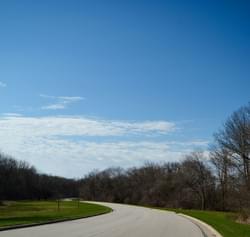




From Draft Milwaukee County Trails Network Plan, 2007 Milwaukee County Dept. of Parks, Recreation, and Culture
Considering the many factors that go into estimating costs for building and managing trails, railtrails, and greenways with examples from Wisconsin.

The cost of new trail construction is difficult to generalize because of the many variables that are involved. Trail surface, width, location, needed structures, signage, and amenities all affect total construction cost. For a more realistic trail construction estimate that does include trail amenities, bridges, signage and drainage issues, four summaries with data from Milwaukee County and the City of Milwaukee are provided here:
*The major increase in the Root River project is due to drainage culverts and railings
Currently, almost all trails in Milwaukee County are asphalt trails, but with the development of future trail corridors, there is a possibility of more crushed gravel or concrete trails and natural surface trails in the future. Figures for asphalt, crushed gravel, and concrete maintenance costs are included below.
Maintenance of asphalt, concrete, and crushed gravel trails differs due to the different properties of the materials. Periodic maintenance of a crushed gravel trail is greater since it is more susceptible to adverse weather conditions such as rainstorms and run-off. Heavy amounts of water running on the trail can cause ruts to form and soften the trail as a whole. More use on a soft trail will cause greater damage to the overall smooth surface and require grading. One advantage to a crushed gravel trail is that it is not affected much by the freeze/thaw cycle that exists in the Milwaukee area. Although asphalt and concrete trails are generally not affected by rain and water erosion, freeze/thaw cycles can cause buckling, creating potholes and cracks which can be dangerous and costly to repair.
Regardless of trail surface type, there are many other factors that can affect cost of maintenance. The main factor affecting cost is the difference in agencies that maintain and operate trails. Each agency will have different labor costs, access to different machinery and equipment, and may or may not have a volunteer base to offer assistance.
Maintenance and operation costs can also have a broad definition. For the purpose of this report, maintenance and operation costs will be classified as routine maintenance. Routine maintenance can be defined as maintenance that is needed to keep the trail operating in a safe and usable condition, not involving major trail development for reconstruction. Below is a list of routine maintenance activities:
** snowplowing is also a routine maintenance activity but will be broken out into a separate cost listed below.
Research was conducted to determine annual per mile maintenance costs for off-street trails. Some estimates found were specific to a trail surface type and others were not. Interestingly, maintenance and operation costs are very similar whether a surface is crushed gravel or asphalt. Due to the low amount of concrete bike trails, a routine maintenance figure could not be found. Below is a list of maintenance costs from various sources:
$1,500 per mile provided in the Iowa Trails 2000 plan by the Iowa Department of Transportation (includes a mixture of different trail surfaces)
$2,525 per mile summarized by the Milwaukee County Park System (all asphalt paths)
$1,200 per mile (as an absolute minimal cost) in the Rail Trail Maintenance & Operation Manual provided by the Rails to Trails Conservancy.
$2,077 per mile for government run trails provided in the Rail Trail Maintenance & Operation Manual provided by the Rails to Trails Conservancy.
$2,042.06 per mile of unpaved trail in the Trail Cost Model - Draft by the Wisconsin Department of Natural Resources.
Snow removal costs range from $24.13/mile on the Glacial Drumlin Trail - E to $154.13/mile on the Red Cedar State Trail. Although snow removal does occur on portions of Milwaukee County's Oak Leaf Trail, no cost estimate could be separated out.
Recent Milwaukee County Parks Trail Maintenance Estimate:
Services performed on bike trails, park pathways, and walks. These services include general forestry work, asphalt repair, landscaping, construction, and drainage work.
Forestry: Approximately 16 weeks were spent conducting forestry operations. This involves primarily trimming back encroaching vegetation and removing storm-damaged material. The cost estimate for this is $150,000.
Landscaping: This type of work is generally associated with site restoration needed in conjunction with the installation of new trails and paths. The cost estimate for this work is $110,000.
Construction and Asphalt: The volume of this type of work can vary greatly from year to year. In 2004, approximately 2 weeks of labor was devoted to this. We installed drainage, repaired asphalt, and repaired washouts. The cost of this work was approximately $20,000.
The approximate total is $280,000.
Funding, maintenance needs, and staff levels may vary annually so the above estimate does not remain the same year to year. A maintenance plan and budget need to be created to implement in the future. With trail user counts increasing it is important for the proper maintenance to be performed to ensure trail user safety.